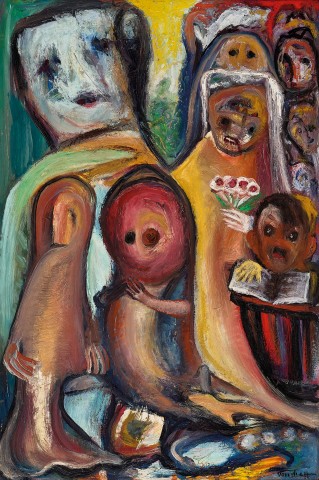THE WEDDING, 1954
DANILA VASSILIEFF
oil on canvas
91.5 x 61.0 cm
signed lower right: Vassilieff
The collection of the artist
A. G. Morant, Melbourne, 1958, a bequest of the artist
Museum of Modern Art and Design, Melbourne, 1959 – 1980
A. G. Morant, Melbourne, returned, 1980
Sue Gough, Queensland, acquired in 1984
Private collection
Sotheby’s, Melbourne, 19 April 1994, lot 183
The Reg Grundy AC OBE and Joy Chambers–Grundy Collection (stamped and label attached verso)
Memorial exhibition of the Paintings and sculpture of Danila Vassilieff, Museum of Modern Art and Design, Melbourne, 9 June 1959
Vassilieff: A Retrospective exhibition of Paintings, Sculptures and Watercolours, Heide Park and Art Gallery, Melbourne, 11 August – 22 September 1985; National Gallery of Australia, Canberra; Art Gallery of New South Wales, Sydney, cat. 40
St John Moore, F., Vassilieff and His Art, Oxford University Press, Melbourne, 1982, cat. p300, pp. 110 – 11, 113 (illus., dated ‘1952’), 158
St John Moore, F., Vassilieff: a retrospective exhibition of Paintings, Sculptures and Watercolours, Heide Park and Art Gallery, Melbourne, 1985, p. 27
Bojić, Z., Imaginary homelands: the art of Danila Vassilieff, Andrejević Endowment, Serbia, 2007, pl. 23, pp. 44, 131
St John Moore, F., Vassilieff and his art, Macmillan Art Publishing, Melbourne, 2012, cat. 379, pp. 130, 132, 133 (illus.), 210
The son of a Cossack father and Ukrainian mother, Danila Vassilieff cut an exotic figure in 1930s Melbourne, where he arrived in mid-1937, having eloped from Sydney with his third wife. His liberated approach to art-making eschewed formal training and the necessity for fine materials, and his belief that the creative act was something immediate and physical as opposed to being driven by aesthetics and intellect, garnered him enthusiastic friends and followers, especially among the younger artists of the day.1 While some found his direct, expressive style and insistence on painting exactly what he saw as an assault on good artistic taste, others championed his approach. Writing in the Melbourne Herald, Basil Burdett declared, ‘[Vassilieff’s art] is as different from average Australian painting as chalk is from cheese, but it is the authentic vision of a man of sensibility and power whose vivid sense of life must out, like murder.’2
Vassilieff was a notorious womaniser, ruggedly handsome, charismatic and confident in his charm and appeal. When, in 1947, Elizabeth Hamill offered to buy ‘Stonygrad’, the house he had built in Warrandyte using local, hand-quarried stone, Vassilieff was instantly attracted and famously chased her around the table, saying, ‘You buy the house, you buy me. You have me and the house for the same price.’3 Remarkably, Hamill took up the impromptu offer and the pair were married the following month. The artist’s passion for his new wife is reflected in an extended series of expressive, boldly coloured oil paintings he produced that year which focus on her face, recording her fine features and fair hair.4 It was also at this time that Vassilieff began to carve stone sculptures, taking naturally to the new technique, and making the most of the textural and colour variations offered by his material.
Striking in scale, The Wedding, 1954 is part of a series of thematically-linked paintings which, as Felicity St John Moore describes, reflects Vassilieff’s state of being in the face of the impending breakdown of his relationship with Elizabeth.5 Unlike earlier paintings where he draws with the paintbrush, leaving much of the white ground exposed, here the panel is completely covered with paint. Strong colour is laid down in decisive and heavily textured brushstrokes, conveying both the physicality and psychologically-driven energy of his approach. The emotion of the moment is visible in the face of the groom and his figure dominates the scene, looming above the diminutive bride, who wears a long yellow gown and white veil, her gloved hand holding a posy of red and white flowers. Vassilieff moved between the depiction of more realistic imagery and a distinctive, immediately recognisable style of expressionism during these years, and it is in works such as The Wedding that the absolute originality of his vision and the power of its expression are most fully communicated.
1. See St. John Moore, F., Vassilieff and His Art, Oxford University Press, Melbourne, 1982, p. 42
2. Burdett, Basil, Herald, Melbourne, 16 September 1937, cited in St John Moore, F., Vassilieff and His Art, Macmillan, Melbourne, 2012, p. 46
3. Vassilieff cited in St John Moore, 2012, ibid., p. 91
4. Eight of these portraits are in the Rosenblatt Family Collection, Melbourne: see Miekus, Tiarney, ‘Artist Danila Vassilieff was selling his house. There was just one catch’, Sydney Morning Herald, 7 August 2020, accessed online, 17 October 2022
5. St John Moore, 2012, op. cit., p. 130
KIRSTY GRANT
